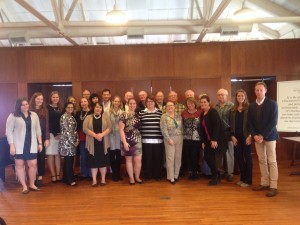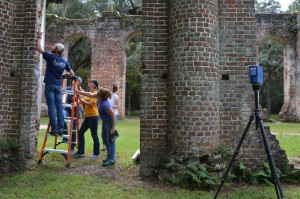During the spring 2015 semester, MSHP students in the First Year Preservation Studio assessed the condition of the ruins of the Progressive Club on John’s Island in Charleston County. Building on the results of this investigation, Professors Hudgins and Leifeste presented a paper entitled Race and Ruin: The Progressive Club and the Challenge of Preserving a Significant Place with a Tenuous Architecture at the annual meeting of the Southeast Chapter of the Society of Architectural Historians on October 15.
Now a roofless ruin, the Progressive Club on John’s Island, South Carolina housed a vital community center from 1963 to 1972 that was fundamental to the advancement of the local African American community and important for the Civil Rights Movement nationally. The “Citizenship School” developed here in response to local needs for literacy training, political empowerment, and employment networking became a model spread throughout the South. The Progressive Club served basic community needs as a grocery store, childcare center and meeting space, and it and its members provided transportation and lodging opportunities for African Americans traveling during the era of segregated public accommodations. The founder of the Club, Esau Jenkins, is a notable national figure in the pursuit of civil rights justice. What Jenkins and his collaborators contributed to the social, cultural, and political transformation of the late twentieth-century South is wildly out of scale with this modest building. The Progressive Club is, in short, one of those ordinary places where extraordinary people made history in a building now little appreciated for its historical significance and the connection it provides to that history. How do preservationists and public historians deal with places whose significance resides in intangible contexts and in historic events that left few indelible architectural signatures? How should preservationists proceed when historically significant places are neither particularly evocative, nor architecturally compelling, nor, in the case of the Progressive Club, especially stable?
The memorialization of ruins in the South Carolina Lowcountry is determined by who cares for them, the sources of the ruin’s significance, the scale, aesthetic qualities and specific conditions of deterioration of the ruin. Long- tended ruins in the South Carolina Lowcountry include the Bennett Rice Mill Façade, Old Fort Dorchester, Peachtree Plantation, Pon Pon Chapel, and Sheldon Church Ruins. Each represents a different manner of treatment and interpretation. Each ruin serves a different role in connecting Lowcountry communities to shared pasts. These antebellum ruins were raised with materials and by building methods more durable than those used in the construction of the Progressive Club, however. These architectural differences reflect historical inequities and present contemporary technical challenges. This aspect of the Progressive Club speaks to larger challenges of preserving late twentieth-century vernacular buildings.
Furthermore, the Progressive Club differs from many other ruins in that the community has declared its intention to preserve and interpret the legacy the ruin embodies. Should preservation take the form of an emphasis on a living legacy with a reconstruction or replacement building to support the social and programmatic functions under the next generation of the Club or should preservation take the form of stabilization and conservation of the ruins? The Progressive Club, at this current phase of preservation planning, raises more questions than answers. In challenging a traditional assumption that architectural value determines preservation treatment, the Preservation Club is a provocative case study of how important historical narratives may live on through remaining architectural fabric whether monumental and mundane.













